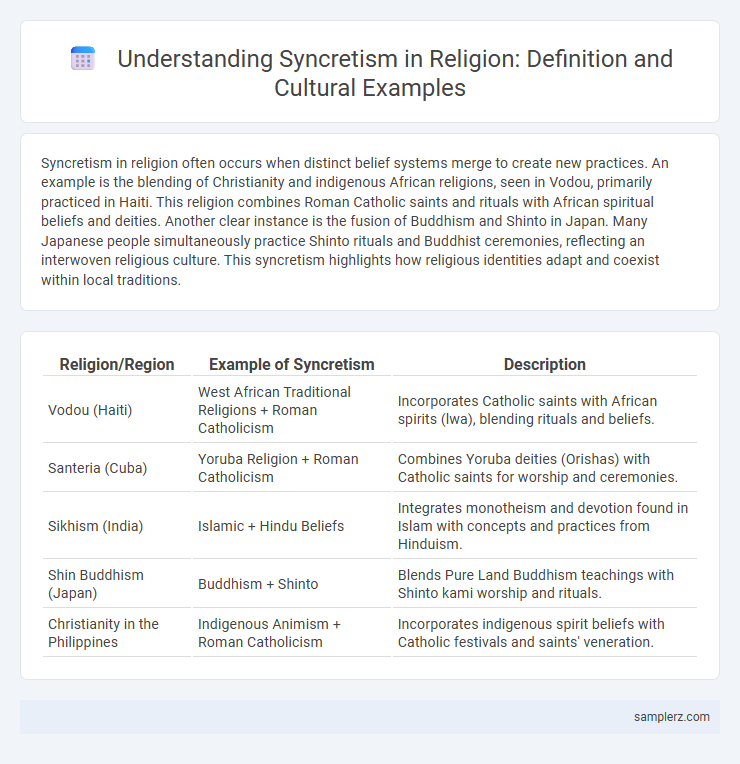Syncretism in religion often occurs when distinct belief systems merge to create new practices. An example is the blending of Christianity and indigenous African religions, seen in Vodou, primarily practiced in Haiti. This religion combines Roman Catholic saints and rituals with African spiritual beliefs and deities. Another clear instance is the fusion of Buddhism and Shinto in Japan. Many Japanese people simultaneously practice Shinto rituals and Buddhist ceremonies, reflecting an interwoven religious culture. This syncretism highlights how religious identities adapt and coexist within local traditions.
Table of Comparison
| Religion/Region | Example of Syncretism | Description |
|---|---|---|
| Vodou (Haiti) | West African Traditional Religions + Roman Catholicism | Incorporates Catholic saints with African spirits (lwa), blending rituals and beliefs. |
| Santeria (Cuba) | Yoruba Religion + Roman Catholicism | Combines Yoruba deities (Orishas) with Catholic saints for worship and ceremonies. |
| Sikhism (India) | Islamic + Hindu Beliefs | Integrates monotheism and devotion found in Islam with concepts and practices from Hinduism. |
| Shin Buddhism (Japan) | Buddhism + Shinto | Blends Pure Land Buddhism teachings with Shinto kami worship and rituals. |
| Christianity in the Philippines | Indigenous Animism + Roman Catholicism | Incorporates indigenous spirit beliefs with Catholic festivals and saints' veneration. |
Origins of Syncretism in World Religions
Syncretism in world religions often originates from cultural exchanges along trade routes such as the Silk Road, where beliefs from Buddhism, Zoroastrianism, and Hellenistic traditions merged. The spread of Alexander the Great's empire facilitated the fusion of Greek and Eastern religious elements, exemplified by Greco-Buddhism. Early Christianity also integrated aspects of pagan Roman rituals and Jewish theology, creating a unique syncretic faith that shaped Western religious history.
Syncretic Practices in Ancient Religions
Syncretic practices in ancient religions are exemplified by the blending of Egyptian and Greek deities, such as the fusion of Osiris and Dionysus, which created a composite god embodying traits of death and resurrection. The Roman Empire showcased syncretism through the assimilation of local gods into the Roman pantheon, promoting religious cohesion across diverse cultures. Ancient Mesopotamian religions also merged attributes of gods like Marduk and Enlil, reflecting political and cultural integration within their evolving spiritual frameworks.
Blending Traditions: Christianity and Paganism
Blending traditions of Christianity and Paganism is evident in practices such as the celebration of Christmas, which incorporates elements like the Christmas tree and Yule log originating from ancient pagan rituals. The integration of Easter with symbols like eggs and rabbits derives from pre-Christian fertility festivals. These syncretic customs illustrate how religious syncretism fosters cultural continuity and adaptation by merging diverse spiritual beliefs and rituals.
Afro-Caribbean Syncretism: Santería and Vodou
Afro-Caribbean syncretism in religion is exemplified by Santeria and Vodou, which blend African Yoruba and Fon spiritual practices with Catholicism. Santeria incorporates Catholic saints as representations of Yoruba orishas, facilitating covert worship under colonial religious rule. Vodou merges West African Vodun deities with Catholic iconography, creating a unique spiritual system that reflects the cultural resilience of enslaved communities in the Caribbean.
Hinduism and Buddhist Syncretism in Southeast Asia
Hinduism and Buddhism in Southeast Asia merged through syncretism, blending Hindu deities with Buddhist teachings in temples like Angkor Wat. This fusion influenced local practices, where Hindu epics such as the Ramayana were integrated into Buddhist rituals and arts. The syncretic culture enriched religious diversity and shaped regional identities across Thailand, Cambodia, and Indonesia.
Japanese Religious Syncretism: Shinto and Buddhism
Japanese religious syncretism exemplifies the fusion of Shinto and Buddhism, where sacred kami worship coexists with Buddhist rituals and doctrines. This syncretism is evident in practices like Shinbutsu-shugo, where Shinto shrines house Buddhist statues and Buddhist temples enshrine kami deities, reflecting harmonious religious integration. The syncretic tradition significantly shaped Japan's spiritual landscape, influencing festivals, architecture, and daily worship since the introduction of Buddhism in the 6th century.
Islamic Influence on Indigenous African Traditions
Islamic influence on indigenous African traditions demonstrates significant religious syncretism, where Islamic beliefs merge with local customs and practices. For example, Sufi orders in West Africa incorporate Islamic teachings with animist rituals, creating unique spiritual experiences that honor both faiths. This fusion enhances communal identity and spiritual diversity across regions like Senegal, Mali, and Nigeria.
Syncretic Elements in Latin American Catholicism
Latin American Catholicism exhibits syncretic elements blending indigenous beliefs with Roman Catholic practices, such as the veneration of the Virgin of Guadalupe alongside pre-Columbian deities. Rituals incorporating indigenous music, dance, and offerings coexist with Catholic sacraments, illustrating a fusion of spiritual traditions. This syncretism reflects cultural resilience, maintaining native identity within the framework of imposed colonial religion.
Modern Examples of Religious Syncretism
Modern examples of religious syncretism include the blending of Christianity and indigenous beliefs in Latin America, where Catholic saints are often intertwined with local deities and rituals. In Japan, the fusion of Shinto and Buddhism creates unique practices and festivals that reflect elements of both traditions. Afro-Caribbean religions like Santeria combine Yoruba spirituality with Catholicism, demonstrating syncretism through shared symbols and ceremonies.
Impact of Syncretism on Cultural Identity
Syncretism in religion, such as the fusion of indigenous beliefs with Christianity in Latin America, profoundly shapes cultural identity by blending diverse spiritual practices into a unique syncretic tradition. This integration fosters a shared sense of community and continuity, allowing marginalized groups to preserve ancestral elements within dominant religious frameworks. The impact extends beyond spirituality, influencing language, rituals, art, and social norms that define cultural heritage and collective memory.

example of syncretism in religion Infographic
 samplerz.com
samplerz.com